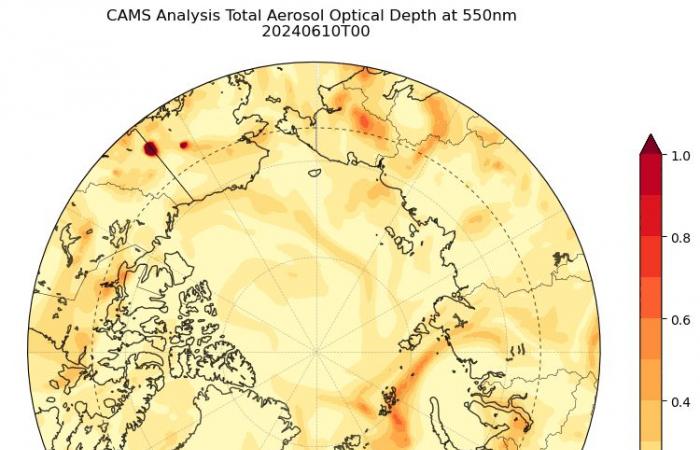The Copernicus Atmosphere Monitoring Service (CAMS) monitored emissions from fires and the consequent transport of smoke into the Arctic Circle during June 2024. Most of the fires is burning in Russia’s Sakha Republic, which recorded high-intensity fires in the summer of 2021. Data from the CAMS Global Fire Assimilation System (GFAS) shows that carbon emissions from the June fires are already the third highest of the last two decades, following the significant fire seasons of 2019 and 2020.
The Arctic region of the Sakha Republic is experiencing much higher surface air temperatures and drier surface conditions than usual for this time of year, providing favorable environmental conditions for post-ignition fires. CAMS scientists have monitored a significant increase in total daily fire radiative power (FRP), which indicates the intensity of fires, and smoke emissions across the region.
The total monthly carbon emissions from the June fires, estimated by CAMS from FRP observations, are the third highest in two decades, at 6.8 megatonnes of carbon, behind June 2020 and 2019, which recorded 16.3 respectively. and 13.8 megatonnes of carbon.
Mark ParringtonSenior Scientist at the Copernicus Atmosphere Monitoring Service, said: “In the fire emissions monitoring we do at CAMS we pay particular attention to the high northern latitudes and the Arctic during the summer months. Arctic fire emissions have been at fairly typical levels for the past three summers, but we have observed that recent fires are developing as a result of hotter and drier conditions, similar to the widespread fires of 2019 and 2020. This is the third time since 2019 that we have observed significant fires in the Arctic and have shown that this northeastern region of the Arctic has experienced the largest increase in extreme fires in the last two decades“.
Changes in the Arctic climate are of great importance for everyone, as they affect the entire earth system. With this in mind, CAMS worked with Arctic Basecamp to translate fire data into a warning system for notable climate events in the Arctic.
Gail WhitemanProfessor at the University of Exeter and founder of Arctic Basecamp, commented: “The Arctic is ground zero for climate change, and the increasingly frequent fires in Siberia are a clear warning sign that this essential system is approaching dangerous climate tipping points. What happens in the Arctic doesn’t stay there: Arctic change amplifies global risks for all of us. These fires are a wake-up call for urgent action“.
In addition to fires in the Arctic, CAMS has also been closely tracking the intensity and emissions of fires burning in the Pantanal wetlands, located in Brazil, Bolivia and Paraguay. In the Brazilian province of Mato Grosso do Sul (where most of the Pantanal wetlands are located), total daily FRP has been significantly higher than average for several weeks, and total carbon emissions for May and June are more than double the previous highest values in the GFAS dataset during May-June 2009. The estimated May-June total emissions are also the highest in the last two decades for Bolivia and Paraguay and the highest for Brazil since 2004.
Continue reading on MeteoWeb






